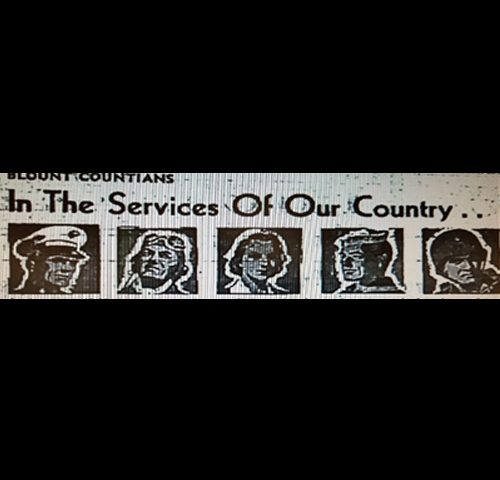Are You All In?

A WWII Thanksgiving Story
December 1, 2019
My Conversation with WWII Veteran Combat Engineer, Joe Berger
July 19, 2020In the past few months have you been asked, “Are you all in?” Perhaps someone is asking you about a business deal, an innovative idea, or a challenging adventure. While this question was rarely asked during the 1940’s, the all-in concept was fully embraced in WWII. Recently I discovered what that really meant.
Last week, I was in Maryville, Tennessee, my hometown to track down articles published in their local paper during 1943. Several of my father’s letters written from New Guinea that year had mentioned important newspaper clippings. Curious, I wondered if I could find any of them. With the help of the reference librarian, I installed a microfiche tape containing the 1943 issues of the Maryville Times, and then slowly began my search. As I scrolled through the often-scratchy 77-year-old print and worked to steady the focus, I was amazed by the images I saw and what I learned.
From page to page, it became very clear that this small community in East Tennessee was fully engaged in the war effort. I had read articles describing how our country had mobilized through activities such as gas, sugar, coffee rationing and collecting scrape metal and rubber. But until I scanned those newspapers, I did not fully understand the magnitude of these efforts. From the front-page cover stories to the special feature sections plus the advertisements and announcements, these citizens were all in!
What captured my attention immediately was Blount Countians in the Services of our Country, a regular feature at the top of page two. Primarily devoted to news about local boys, it included the names of volunteers who had been called for induction. As I read that brief clip in the August 13 edition, I was shocked to see a familiar name: Raymond Snider. He had recently married Irene Jett, one of my father’s sisters and would soon be inducted into the Navy. What an unexpected find!
Other news on that page contained details about the service men who had completed basic training, were on furlough or home on leave. There was even a short write up about a young Naval Cadet from Townsend, Tennessee, who had written his mother about his new military life including the fact that he had gained 17 pounds in a month. My father who was serving in New Guinea in ’43 would not have been surprised by that young cadet’s story. He wrote a letter home saying that the Navy men always had the best food.
Perhaps this young recruit’s motivation to serve was both patriotic and practical. Many families in that area had not yet recovered from the devasting effects of the depression so landing a steady job, gaining new skills, and traveling the world along with three meals a day was a good deal. His mother who had shared his letter with the Times was extremely proud of her son.
Then there were the business ads of the local grocers, department stores, gas stations, jewelers, and tailors. They were unlike anything I had ever seen. Each advertisement carried a war related message along with their products. The A&P grocery chain was a prime example as it enticed shoppers with their weekly food specials then encouraged them to “Buy War Stamps! Help Build a Mystery Ship” with their extra change.
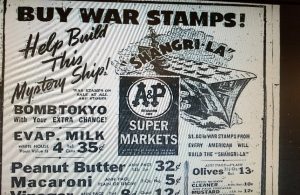
Along with the sale of war stamps, readers were also encouraged to buy war bonds. This was a major initiative as the bonds helped fund the war and provided every citizen another opportunity to support the overall war effort. The August 5, 1943 headline described these efforts and the success of a JC Penney’s employee who helped raise $82,000 during a recent war bond drive. Several weeks later Penney’s paid tribute to twelve service boys from their store and encouraged shoppers to buy bonds to support these local guys.
Cartoons were a popular medium that frequently reinforced recruitment efforts and war priorities. On the first anniversary of the establishment of the Navy WAVES (Women Accepted for Volunteer Emergency Service, the WWII women’s branch of the Naval Reserve), a sketch encouraged women to step forward to fill over 1000 jobs vacated by men leaving to serve overseas. In another edition, farmers were urged to do their part by meeting their farm production goals.

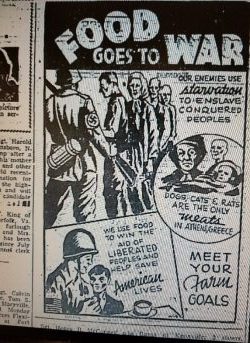
That August, recruitment efforts were also intensified for males between the ages of 17-27 to become aviation cadets with the Army Air Corps. The goal for East Tennessee alone was 685 men and several businesses found creative ways to promote this campaign. Sam Jett, my dad’s brother, and co-owner of Jett’s service station was a civilian pilot and on August 16, he sponsored a large ad urging boys to sign up at the local Civil Air Patrol office. Sam wasn’t the only businessman supporting this effort as a few weeks later a similar ad was posted by the United Jewelry & Loan company.

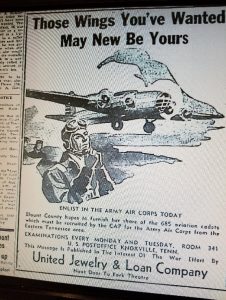
The newspaper also carried other ads reflecting the war’s impact. In May of 1942, the U.S Office of Defense Transportation had established a national 35 mph victory speed limit to conserve gas and rubber. This restriction along with the gas rationing, started the previous December, impacted everyone as well. As a result, some businesses had to reduce or limit their services. In a July advertisement, Maryville Dry Cleaners announced the end of their pickup and delivery services to help conserve gasoline. Also, with people currently driving at such slow speeds, their cars needed a lighter grade of oil for maximum performance. So, the Sinclair Dealers sponsored an ad urging drivers to stop in for the updated light-oil change. Every week it seemed there was additional information about navigating their ever-changing Home Front lives.
While my visit to the Blount County Library on Wednesday February 5, helped me locate the articles my father had mentioned, it also showed me in a very dramatic/realistic way the enormity of the Home Front involvement and cooperation. During WWII, being all in, was not a high-minded concept. Instead it was an essential strategy that helped Americans and the Allies win the war. Like many children of that era, I am so grateful for everything they did to help bring WWII to a close. Now seventy-five years later, it’s important that we still acknowledge and appreciate how our parent’s total commitment, extreme courage, and generous sacrifice changed the world. Without a doubt, these men and women were all in!
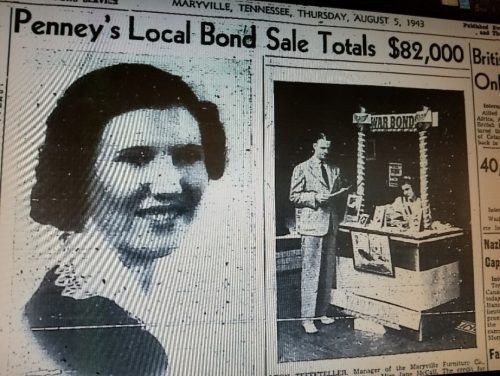
A special thanks to the reference librarians at the Blount County Library for their tremendous help.

